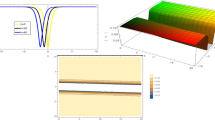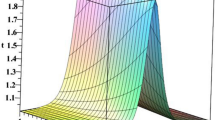Abstract
This paper obtains optical soliton solutions of the Kudryashov’s model with arbitrary refractive index. Three integration algorithms collectively revealed a full spectrum of single solitons along with a straddled soliton. The constraint conditions for the existence of such solitons are also listed. Finally, the only conserved quantity, supported by the model, is penned down.
Similar content being viewed by others
Avoid common mistakes on your manuscript.
Introduction
The captivating theory and dynamics of optical solitons forms an engineering marvel in telecommunications industry [1,2,3,4,5,6,7,8,9,10]. There are several forms of self-phase modulation (SPM) structures that make this dynamics a reality. While several new models are being continuously proposed, abundant models have been lately introduced by Kudryashov [1, 3,4,5,6,7,8,9]. A couple of them have been recently labeled as Kudryashov’s law of refractive index and Kudryashov’s generalized law of refractive index. The current paper is another form of SPM that was proposed by Kudryashov and it was coined as arbitrary refractive index [8, 9]. Thus, the title of the manuscript is kept as such. This form of SPM is a combination of two or three types of previously studied laws. It linearly combines dual-power law and non-local nonlinearity but with any arbitrary exponent, odd or even, either way. This proposed law of nonlinear refractive index will be explored in today’s paper with the governing nonlinear Schrödinger’s equation (NLSE) that is going to be addressed in presence of chromatic dispersion (CD).
The paper will integrate NLSE using a few algorithms that will reveal soliton solutions to the model and thus will make the model a viable candidate for soliton transmission through optical fibers or other such form of equivalent waveguides. There is only one form of conservation law that is also recovered from this model and is exhibited at the end. The presence of the generalized form of non-local form of nonlinearity prevents the retrieval of additional forms of conservation law.
Three well-known powerful integration schemes are adopted in the paper to handle the model from its integrability perspective. These integration schemes implemented in the paper are Riccati equation method, F-expansion scheme and finally the trial equation algorithm. These methodologies collectively retrieved a full spectrum of single solitons and in addition F-expansion revealed a straddled singular soliton structure. The existence criteria for such solitons are also listed as their respective parameter constraints. Surface plots of bright and dark solitons are also included for visual illustration. The analytical details of these are discussed in the remainder of the paper after a quick intro to the governing model.
Governing model
The dimensionless form of NLSE Kudryashov’s form of arbitrary refractive index is [8]:
where x represents spatial variable while t represents temporal variable. Then, \(q\left( x,t\right)\) is the complex-valued dependent variable and it stands for the soliton profile. Next, a is the coefficient of CD and \(i=\sqrt{-1}\). The constants \(b_{j}\) for \(1\le j\le 3\) are the coefficients of SPM and n is the power-law nonlinearity parameter.
Mathematical analysis
In order to locate soliton solutions, the following decomposition in phase-amplitude format is carried out:
where
and v is the soliton velocity. Next, from the phase component
where \(\kappa\), \(\omega\) and \(\theta _{0}\) are, respectively, the frequency, wave number and phase constant. Substitute (2) into (1). Real part gives
, while imaginary part leads to the speed of the soliton as
By the use of \(U=Q^{\frac{1}{n}}\), Eq. (5) changes to
Application to NLSE
This section recovers soliton solutions to the model by the application of three algorithms that are detailed in the subsequent subsections.
Riccati equation method
This scheme assumes that Eq. (7) has the formal solution as
where N is the balance number, \(A_{i}\) for \(0\le i\le N\) are constants and \(V(\zeta )\) ensures
with constants \(S_{2}\), \(S_{1}\) and \(S_{0}\). Also, it should be noted that the solutions of Eq. (9) are:
where \(\zeta _{0}\) is a constant and \(\sigma =\) \(S_{1}^{2}-4S_{0}S_{2}\).
From, the balancing principle, the solution (8) becomes
Substituting (11) with (9) into (7) yields
Plugging (12) along with (10) into (11), one recovers dark and singular solitons, respectively
and
with
F-expansion scheme
This methodology suggests that the formal solution of Eq. (7) is:
where N is the balance number, \(A_{i}\) for \(0\le i\le N\) are constants and the function \(F(\zeta )\) provides
with constants P, Q and R. Also, it needs to be mentioned that some solutions of Eq. (17) are listed as:
With the help of the balancing principle, the solution of Eq. (7) reduces to
Putting (19) with (17) into (7) leads to
Inserting (20) along with (18) into (19), one reveals the solutions to the governing model in the forms:
Dark soliton is
singular soliton is
and combo singular solitons are
with
Trial equation algorithm
According to this form of integration norm, the solution of Eq. (7) is adopted as
where N is the balance number, \(A_{i}\) for \(0\le i\le N\) are constants and \(Q\left( \zeta \right)\) is a function that needs to be determined later.
Utilizing the balancing principle gives
Then, plugging (26) into (7), one procures the results
Next, substituting the solution set (27) into (26) brings bout
Consequently, integrating Eq. (28) with respect to Q, bright and singular solitons fall out as
and
with
The following two surface plots represent bright and dark single solitons, respectively. The parameter values chosen are: \(a= -0.4,\ b_2= 0.3,\ b_3= -1,\ n= 1,\ \kappa = 2,\ \omega = 0.2\) (Figs. 1, 2).
Profile of dark soliton (13)
Profile of bright soliton (29)
Conservation law
Invariance of (1) under translation in time t and space x (\(\partial _t\) and \(\partial _x\)), (1) does not admit any Hamiltonian and linear momentum conservation unless \(b_3=0\). That is, the derivative of \(|q|^n\) with respect to x annihilates the conserved Hamiltonian/momentum densities. The notion of approximate conservation is still being developed and we may study these in the future with \(b_3\) relatively ‘small.’ Thus, the only conservation is the ‘power,’ with density \(|q|^2\). Noting that the bright 1-soliton solution to (1) is written as:
where A is the amplitude and B is its inverse width, the power (P) of the soliton is:
Conclusions
This work applies three mathematical algorithms to secure a range of soliton solutions to NLSE that carries arbitrary refractive index form for SPM as proposed by Kudryashov. A full spectrum of soliton solutions, including combo-singular type, has emerged from the scheme that are exhibited along with their existence criteria. The only conservation law that has been located is presented. This work therefore paves the pathway for further development in this regard. One avenue of research would be to address the current model with perturbation terms that would lead to the evolution of additional information. While the prospect of applying soliton perturbation theory no longer exists, because the model does not yield more than one conserved quantity, there are nevertheless additional avenues to venture. This would include application of semi-inverse variational principle and other algorithms to handle perturbation terms that are of Hamiltonian type [11,12,13,14,15,16, 16,17,18,19,20]. The research-rich crew members are thus preoccupied to disseminate these upcoming precious novel results of the model, due to Kudryashov, for gaining momentum, with full throttle, in the fields of quantum optics and telecommunications engineering.
References
A.H. Arnous, A. Biswas, M. Ekici, A.K. Alzahrani, M.R. Belic, Optical solitons and conservation laws of Kudryashov’s equation with improved modified extended tanh-function. Optik 225, 165406 (2021)
G. Genc, M. Ekici, A. Biswas, M.R. Belic, Cubic-quartic optical solitons with Kudryashov’s law of refractive index by \(F\)-expansion schemes. Res. Phys. 18, 103273 (2020)
N.A. Kudryashov, A generalized model for description of propagation pulses in optical fiber. Optik 189, 42–52 (2019)
N.A. Kudryashov, The Painleve approach for finding solitary wave solutions of nonlinear nonintegrable differential equations. Optik 183, 642–649 (2019)
N.A. Kudryashov, Solitary and periodic waves of the hierarchy for propagation pulse in optical fiber. Optik 194, 163060 (2019)
N.A. Kudryashov, Periodic and solitary waves in optical fiber Bragg gratings with dispersive reflectivity. Chin. J. Phys. 66, 401–405 (2020)
N.A. Kudryashov, Optical solitons of mathematical model with arbitrary refractive index. Optik 224, 165391 (2020)
N.A. Kudryashov, Highly dispersive optical solitons of equation with arbitrary refractive index. Regul. Chaotic Dyn. 25(6), 537–543 (2020)
E.M.E. Zayed, R.M.A. Shohib, M.E.M. Alngar, A. Biswas, M. Ekici, S. Khan, A.K. Alzahrani, M.R. Belic, Optical solitons and conservation laws associated with Kudryashov’s sextic power-law nonlinearity of refractive index. Ukrain. J. Phys. Opt. 22(1), 38–49 (2021)
A. Biswas, Optical soliton cooling with polynomial law of nonlinear refractive index. J. Opt. 49(4), 580–583 (2020)
E.M.E. Zayed, M.E.M. Alngar, A. Biswas, A.H. Kara, L. Moraru, M. Ekici, A.K. Alzahrani, M. Belic, Solitons and conservation laws in magneto-optic waveguides with triple-power law nonlinearity. J. Opt. 49(4), 584–590 (2020)
O. Gonzalez-Gaxiola, A. Biswas, M. Ekici, S. Khan, Highly dispersive optical solitons with quadratic-cubic law of refractive index by the variational iteration method. J. Opt. (2021). https://doi.org/10.1007/s12596-020-00671-x
J. Vega-Guzman, A. Biswas, M. Asma, A.R. Seadawy, M. Ekici, A.K. Alzahrani, M.R. Belic, Optical soliton perturbation with parabolic-nonlocal combo nonlinearity: undetermined coefficients and semi-inverse variational principle. J. Opt. (2021). https://doi.org/10.1080/17415977.2011.603088
Y. Yildirim, A. Biswas, A.H. Kara, M. Ekici, A.K. Alzahrani, M.R. Belic, Cubic-quartic optical soliton perturbation and conservation laws with generalized Kudryashov’s form of refractive index. J. Opt. (2021). https://doi.org/10.1007/s12596-021-00681-3
E.M.E. Zayed, A.-G. Al-Nowehy, M.E.M. Alngar, A. Biswas, M. Asma, M. Ekici, A.K. Alzahrani, M.R. Belic, Highly dispersive optical solitons in birefringent fibers with four nonlinear forms using Kudryashov’s approach. J. Opt. (2021). https://doi.org/10.1007/s12596-020-00668-6
M.S.M. Rajan, A. Mahalingam, Nonautonomous solitons in modified inhomogeneous Hirota equation: soliton control and soliton interaction. Nonlinear Dyn. 79(4), 2469–2484 (2015)
M.S.M. Rajan, A. Mahalingam, Multi-soliton propagation in a generalized inhomogeneous nonlinear Schrödinger-Maxwell-Bloch system with loss/gain driven by an external potential. Journal of Mathematical Physics. 54(4), 043514 (2013)
M.S.M. Rajan, A. Mahalingam, A. Uthayakumar, K. Porsezian, Observation of two soliton propagation in an erbium doped inhomogeneous lossy fiber with phase modulation. Commun. Nonlinear Sci. Numer. Simul. 18(6), 1410–1432 (2013)
M.S.M. Rajan, Dynamics of optical soliton in a tapered erbium-doped fiber under periodic distributed amplification system. Nonlinear Dyn. 85(1), 599–606 (2016)
M.S.M. Rajan, A. Mahalingam, A. Uthayakumar, Nonlinear tunneling of optical soliton in 3 coupled NLS equation with symbolic computation. Ann. Phys. 346, 1–13 (2014)
Acknowledgements
The research work of the seventh author (MRB) was supported by the Grant NPRP 11S-1126-170033 from QNRF, and he is thankful for it. The authors also declare that there is no conflict of interest.
Author information
Authors and Affiliations
Corresponding author
Additional information
Publisher's Note
Springer Nature remains neutral with regard to jurisdictional claims in published maps and institutional affiliations.
Rights and permissions
About this article
Cite this article
Yıldırım, Y., Biswas, A., Kara, A.H. et al. Optical solitons and conservation law with Kudryashov’s form of arbitrary refractive index. J Opt 50, 542–547 (2021). https://doi.org/10.1007/s12596-021-00688-w
Received:
Accepted:
Published:
Issue Date:
DOI: https://doi.org/10.1007/s12596-021-00688-w






